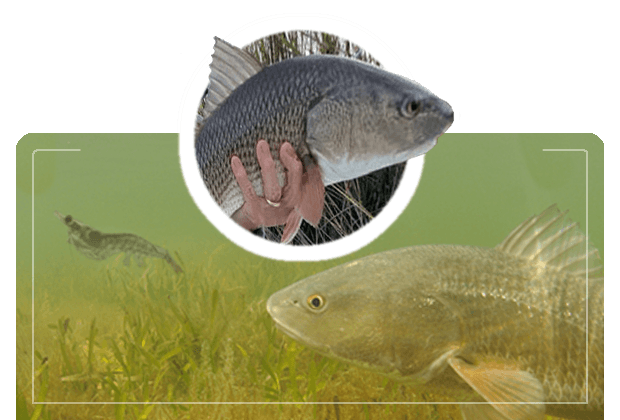What Do Redfish Eat? A Comprehensive Guide
Redfish, also known as red drum or Sciaenops ocellatus, are popular sport fish native to the Atlantic Ocean and Gulf of Mexico. As opportunistic predators, their diet can vary depending on their habitat, age, and availability of prey. In this article, we will explore the feeding habits of redfish in detail.
Table of Contents
Habitat and Distribution
Redfish are commonly found in the following habitats:
- Estuaries
- Coastal marshes
- Shallow bays
- Tidal creeks
- Oyster reefs
- Mudflats
Their range extends from Massachusetts to the Gulf of Mexico, including the southern Atlantic coast and the entire Gulf Coast.
Life Stages and Feeding Habits
Redfish go through different life stages, and their diet changes as they grow from juveniles to adults.
Juvenile Redfish
Juvenile redfish, also known as “rat reds,” typically feed on:
- Small crustaceans
- Grass shrimp
- Mysid shrimp
- Amphipods
- Small fish
- Killifish
- Silversides
- Insects and zooplankton (when very young)
Juveniles tend to remain in shallow waters, where they find ample food sources among seagrass beds and oyster reefs.
Adult Redfish
As redfish grow, their diet shifts to larger prey items. Adult redfish primarily consume:
- Larger crustaceans
- Blue crabs
- Stone crabs
- Mud crabs
- Larger fish
- Menhaden
- Mullet
- Pinfish
- Mollusks
- Clams
- Squid
Adult redfish can be found in a variety of habitats, including deeper waters near shorelines, channels, and passes.
Diet Composition
Redfish are opportunistic feeders, meaning their diet is composed of a wide range of prey items, depending on availability.
Crustaceans
Crustaceans make up a significant portion of a redfish’s diet. They include:
- Shrimp
- Grass shrimp
- Mysid shrimp
- White shrimp
- Brown shrimp
- Crabs
- Blue crabs
- Stone crabs
- Mud crabs
- Amphipods
Fish
Redfish also feed on a variety of small to medium-sized fish, such as:
- Menhaden
- Mullet
- Pinfish
- Anchovies
- Killifish
- Silversides
Mollusks
Mollusks, though a smaller portion of their diet, still play a role in a redfish’s feeding habits. They consume:
- Clams
- Squid
- Oysters
- Snails
Feeding Adaptations
Redfish possess several adaptations that help them effectively locate and capture their prey:
- Inferior Mouth Position: The downward-facing mouth allows redfish to efficiently feed on bottom-dwelling organisms, such as crustaceans and mollusks.
- Pharyngeal Teeth: These specialized teeth, located in the throat, help redfish crush and grind the shells of their prey, such as crabs and mollusks.
- Barbels: Redfish have small barbels, or whisker-like structures, on their chin. These sensory organs help them detect prey hidden in the sediment.
- Camouflage: Redfish exhibit countershading, with a darker back and a lighter belly. This coloration helps them blend into their surroundings, making it easier for them to ambush prey.
Wrapping up this article
Redfish are opportunistic predators that consume a diverse diet of crustaceans, fish, and mollusks. As they grow, their feeding habits change, with adults primarily preying on larger organisms. Their various adaptations, such as their inferior mouth position, pharyngeal teeth, and camouflage, allow them to effectively locate and capture prey in their native habitats. Understanding the diet and feeding habits of redfish is crucial for anglers and conservationists alike, as it provides valuable insights into the species’ biology, ecology, and role within the ecosystem.
I research and report on fishing, fishing gear/equipment, survival topics, and marketing for outdoors related businesses. I assist here on CB Fishing as the editor. Articles may contain AI researched content. All content is published for education and entertainment purposes only, NOT LIFE, HEALTH, SURVIVAL, FINANCIAL, BUSINESS, LEGAL OR ANY OTHER ADVICE. Learn more about Mark Mayo
- Guide to starting a Fishing Charter business
- Carolina Beach Local Fishing Reports #94RT
- Strategic Fishing Charter Marketing
- Carolina Beach Local Fishing Reports #83RT
- Carolina Beach Local Fishing Reports #73RT
- East Coast Got Em On King Mackerel Tournament 2023
- 2023 Recreational Flounder Season Announced
- Carolina Beach Local Fishing Reports #63RT
- Beginner’s Guide: Your First Fishing Trip in Carolina Beach
- Carolina Beach Fishing Reports #53RT
- King Mackerel Fishing in Carolina Beach, NC: A Comprehensive Guide
- Current Fishing Report and Trends and new “Big Red” Artwork
- Surf Fishing in Carolina Beach, North Carolina
- Early Spring 2023 Carolina Beach Fishing Report
- My Top 10 fish to catch at Carolina Beach, NC!
- What are the Most Popular Fishing Spots in Wilmington, NC?
- How to surf fish for bull reds
- Flounder in the Cape Fear River
- Striped bass in the Cape Fear River
- What’s so special about The Cape Fear River?
- Top 4 fish to target in Carolina Beach, NC
- East Coast Got Em On King Mackerel Tournament starts to wind down
- 2022 ranking results – East Coast Got Em On King Mackerel Tournament
- Flounder Season shortens for 2022


